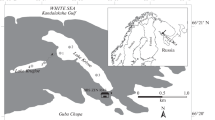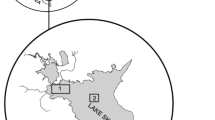Abstract
The development of spawning in perch, pike and roach in Lake Geneva has been studied by means of artificial spawning substrates, laid at different depths, from 1984 to 1993. In Lake Geneva, perch spawned in May. A rise of surface water temperature up to 14 °C stimulated spawning activity while bad weather (surface temperature at 10 °C) induced a spread of the spawning period over more than one month. The spawning period was delayed in years when the mean width of perch egg-ribbons was the largest; this corresponded to the biggest females. At the beginning of the spawning period (early in May), perch preferentially chose a depth of 4 m to spawn. In contrast, at the end of the spawning period, maximum spawning intensity was observed at a depth of 12 m. This phenomenon was more pronounced when water temperature rose above 14 °C in the top 4 m while it remained below 12 °C at a depth of 12 m. Pike spawned at the end of April and at the beginning of May in Lake Geneva. They preferred spruce branches among the different spawning substrates that we tested in Lake Vouglans. When the water temperature increased at the surface of Lake Geneva, pike preferred to lay their eggs on substrates set at 3 m depth where the temperature was cooler than in the surface layer (10.5 °C vs 14 °C). Roach spawned during the last two weeks of May or during the first two weeks of June in Lake Geneva, depending on water temperature. Spawning had generally been spread over a week, but a sudden decrease of water temperature could slow spawning intensity. Roach were able to lay their eggs on natural or synthetic substrates, located 0.5 m below the surface near the shore as well as, at a distance of several hundred metres from the shore. The survival of eggs was always above 90% for perch and roach and generally above 70% for pike.
Similar content being viewed by others
References
Champigneulle, A., M. Melhaoui, D. Gerdeaux, C. Gillet, J. Guillard & R. Rojas-Beltran, 1988. Suivi des pěches de géniteurs d'omble chevalier (Salvelinus alpinus L.) dans la partie française du lac Léman de 1982 á 1987. Premières données sur le pacage lacustre de l'omble. Bull. Fr. Pěche, Pisci. 310: 85–100.
Chevalier, Y., 1988. Biologie du brochet (Esox lucius) du lac Léman. Bull. Soc. Vaud. Sc. Nat., 79: 13–21.
Fortin, R., P. Dumont, H. Fournier, C. Cadieux & D. Villeneuve, 1982. Reproduction et force des classes d'âge du grand brochet (Esox lucius L.) dans le Haut Richelieu et la baie Missisquoi. Can. J. Zool. 60: 227–240.
Frost, W. E., 1965. Breeding habits of Windermere char, Salvelinus willughbii (Gunther) and their bearing on speciation in these fish. Proc. r. Soc. Edinb. B, 163: 232–284.
Gillet, C., 1989. Le déroulement de la fraie des principaux poissons lacustres. Hydroécol. Appl. 1/2: 117–143.
Guma'a, S. A., 1977. A study of young stages or perch (Perca fluviatilis L.) in Windermere. Ph. D. Thesis, University of Lancaster, Lancaster, 126 pp.
Hokanson, K. E. & C. F. Kleiner, 1975. Effects of constant and rising temperature on survival and development rates of embryonic and larval yellow perch, Perca flavescens (Mitchill). In J. H. S. Blaxter (ed.), The early life history of fish, Springer Verlag, Berlin: 437–448.
Holcik, J. & V. Hruska, 1966. On the spawning substrate of the roach (Rutilus rutilus L.) and bream (Abramis brama L.) and notes on the ecological characteristics of some European fishes. Vest. Cesk. Spol. Zool. 30: 22–29.
Jones, D. H., 1982. The spawning of perch, Perca fluviatilis L., in loch Leven, Kinross, Scotland. Fish. Mgmt. 13: 139–151.
Lang, C., 1987. Mortality of perch, Perca fluviatilis L., estimated from the size and abundance of egg strands. J. Fish. Biol. 31: 717–720.
Lang, C. & B. Buttiker, 1985. Abondance et survie des oeufs de perche dans le Léman et le lac de Joux. Bull. Soc. Vaud. Sc. Nat. 77: 285–295.
Machniak, K., 1975. The effects of hydro-electric development on the biology of northern fishes (reproduction and population dynamics). II Northern pike, Esox lucius L., a literature review and bibliography. Fisheries and marine service, Technical report n ° 528, Canada, 82 pp.
Mills, C. A., 1981. The spawning of roach, Rutilus rutilus L., in a chalk stream. Fish. Mgmt. 12: 49–54.
Neveu, G. & C. Bry, 1984. Ovulation spontanée de femelles brochets en petits étangs de maturation. In R. Billard (ed.), Le brochet. Gestion dans le milieu naturel et élevage. INRA Paris: 77–84.
Rubin, J. F. & B. Buttiker, 1993. Les sites de fraye de l'omble chevalier, Salvelinus alpinus L., dans le Léman. Bull. Fr. Pêche Pisci. 325: 69–82.
Souchon, Y., 1984. La reproduction du brochet (Esox lucius L., 1758) dans le milieu naturel: revue bibliographique. In R. Billard (ed.), Le brochet. Gestion dans le milieu naturel et élevage. INRA Paris: 1–33.
Stacey, N. E., A. F. Cook & R. E. Peter, 1979. Ovulatory surge of gonadotropin in goldfish, Carassius auratus. Gen. comp. Endocrinol. 37: 246–249.
Thorpe, J. E., 1977. Morphology, physiology, ecology and behaviour of Perca fluviatilis L. and Perca flavescens Mitchill. F.A.O. Fisheries synopsis, 113, 138 pp.
Treasurer, J. W., 1980. Some aspects of the reproductive biology and early life history of Perch, Perca fluviatilis L. in two Aberdeenshire lochs. D.P. Thesis, University of Aberdeen, 256 pp.
Wilkonska, H. & H. Zuromska, 1967. Observations of the spawning of pike (Esox lucius L.) and roach (Rutilus rutilus L.) in Mazury Lake district. Rocz. Nauk. Roln. ser. H 90:477–502 (In Polish).
Zuromska, H., 1967. Mortality estimation of roach (Rutilus rutilus L.) eggs and larvae on lacustrine spawning grounds. Rocz. Nauk. Roln. ser. H 90: 539–556 (In Polish).
Author information
Authors and Affiliations
Rights and permissions
About this article
Cite this article
Gillet, C., Dubois, J.P. A survey of the spawning of perch (Perca fluviatilis), pike (Esox lucius), and roach (Rutilus rutilus), using artificial spawning substrates in lakes. Hydrobiologia 300, 409–415 (1995). https://doi.org/10.1007/BF00024482
Issue Date:
DOI: https://doi.org/10.1007/BF00024482




